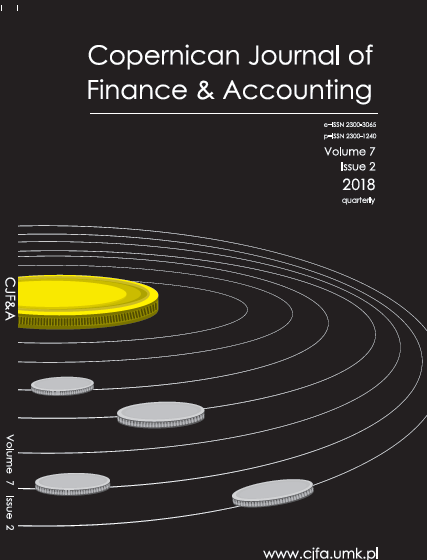MATHEMATICAL MODEL FOR THE EVOLUTIONARY DYNAMIC OF INNOVATION IN CITY PUBLIC TRANSPORT SYSTEMS
DOI:
https://doi.org/10.12775/CJFA.2018.010Słowa kluczowe
technological change, public transportation investment, public transportation, simulation modelingAbstrakt
In this study, a mathematical model is formulated and studied from the perspective of adaptive dynamics (evolutionary processes), in order to describe the interaction dynamics between two city public transport systems: one of which is established and one of which is innovative. Each system is to be influenced by a characteristic attribute; in this case, the number of assumed passengers per unit it that can transport. The model considers the proportion of users in each transport system, as well as the proportion of the budget destined for their expansion among new users, to be state variables. Model analysis allows for the determination of the conditions under which an innovative transportation system can expand and establish itself in a market which is initially dominated by an established transport system. Through use of the adaptive dynamics framework, the expected long-term behavior of the characteristic attribute which defines transport systems is examined. This long-term study allows for the establishment of the conditions under which certain values of the characteristic attribute configure coexistence, divergence, or both kinds of scenarios. The latter case is reported as the occurrence of evolutionary ramifications, conditions that guarantee the viability of an innovative transport system. Consequently, this phenomenon is referred to as the origin of diversity.Bibliografia
Baccini, P., & Brunner, P.H. (2012). Metabolism of the anthroposphere: analysis, evaluation, design. Cambridge: MIT Press. http://dx.doi.org/10.1111/j.1530-9290.2012.00558.x.
Butlin, R.K., Galindo, J., & Grahame, J.W. (2008). Sympatric, parapatric or allopatric: the most important way to classify speciation? Philosophical Transactions of the Royal Society B: Biological Sciences, 363(1506), 2997–3007.
Dercole, F., Dieckmann, U., Obersteiner, M., & Rinaldi, S. (2008). Adaptive dynamics and technological change. Technovation, 28(6), 335–348.
Dercole, F., Prieu, C., & Rinaldi, S. (2010). Technological change and fisheries sustainability: The point of view of Adaptive Dynamics. Ecological Modelling, 221(3), 379–387.
Dercole, F., & Rinaldi, S. (2008). Analysis of evolutionary processes: the adaptive dynamics approach and its applications. Princeton: Princeton University Press.
Dercole, F., & Rinaldi, S. (2010). Evolutionary dynamics can be chaotic: A first example. International journal of bifurcation and chaos, 20(11), 3473–3485. http://dx.doi.org/10.1142/S0218127410027829.
Dieckmann, U., & Law, R. (1996). The dynamical theory of coevolution: a derivation from stochastic ecological processes. Journal of mathematical biology, 34(5–6), 579–612.
Doebeli, M., & Dieckmann, U. (2000). Evolutionary branching and sympatric speciation caused by different types of ecological interactions. The american naturalist, 156(S4), S77–S101.
Geritz, S.A., Meszéna, G., & Metz, J.A. (1998). Evolutionarily singular strategies and the adaptive growth and branching of the evolutionary tree. Evolutionary ecology, 12(1), 35–57.
Geritz, S.A., Metz, J.A., Kisdi, É., & Meszéna, G. (1997). Dynamics of adaptation and evolutionary branching. Physical Review Letters, 78(10), 2024–2027.
Kennedy, C., Stewart, I. D., Ibrahim, N., Facchini, A., & Mele, R. (2014). Developing a multilayered indicator set for urban metabolism studies in megacities. Ecological Indicators, 47, 7–15. http://dx.doi.org/10.1016/j.ecolind.2014.07.039.
Kuznetsov, Y.A. (2013). Elements of applied bifurcation theory (Vol. 112). Berlin: Springer Science & Business Media.
Lai, C.S., Fisher, S.E., Hurst, J.A., Vargha-Khadem, F., & Monaco, A.P. (2001). A forkheaddomain gene is mutated in a severe speech and language disorder. Nature, 413(6855), 519–523.
Landi, P., & Dercole, F. (2016). The social diversification of fashion. The Journal of Mathematical Sociology, 40(3), 185–205. http://dx.doi.org/10.1080/0022250X.2016.1200039.
Núñez-López, M., Velasco-Hernández, J.X., & Marquet, P.A. (2014). The dynamics of technological change under constraints: adopters and resources. American Institute of Mathematical Sciences, 19(10), 3299–3317. http://dx.doi.org/10.3934/dcdsb.2014.19.3299.
Perko, L. (2013). Differential equations and dynamical systems (Vol. 7). Berlin: Springer Science & Business Media.
(www1) Transmilenio, http://www.transmilenio.gov.co/Publicaciones/nuestro_sistema/Componentes/Infraestructura (accessed: 15.05.2018).
(www2) Metro de Medellín, https://www.metrodemedellin.gov.co/quiénessomos (accessed: 15.05.2018).
Pobrania
Opublikowane
Jak cytować
Numer
Dział
Statystyki
Liczba wyświetleń i pobrań: 802
Liczba cytowań: 0



